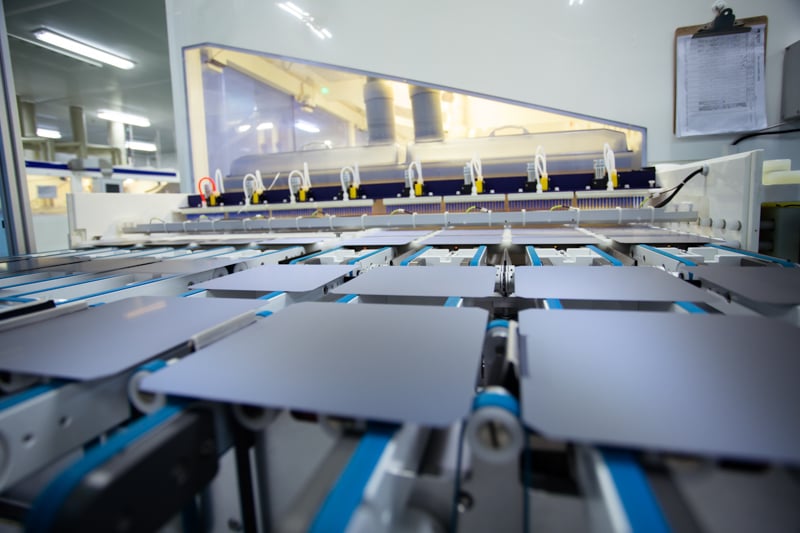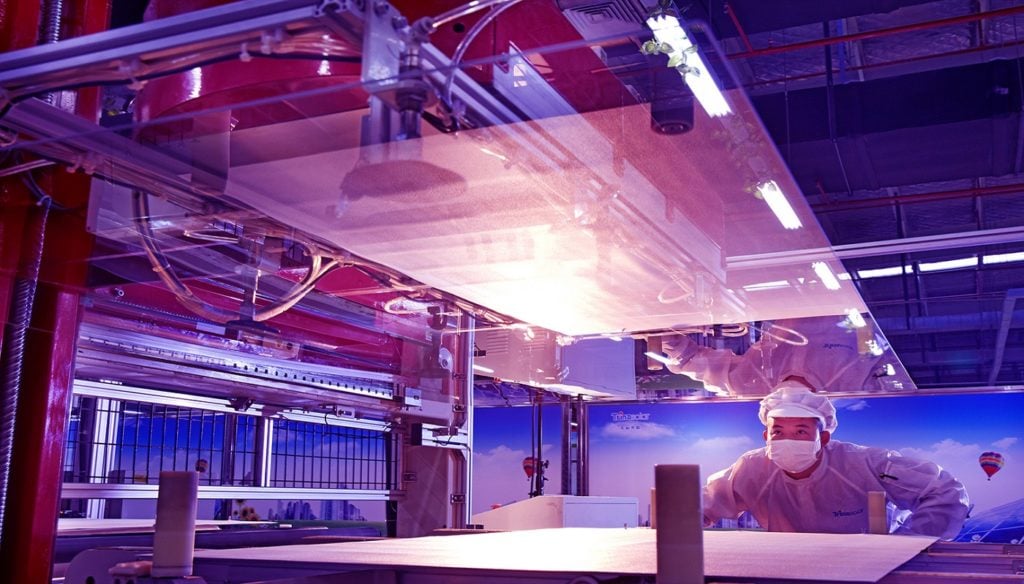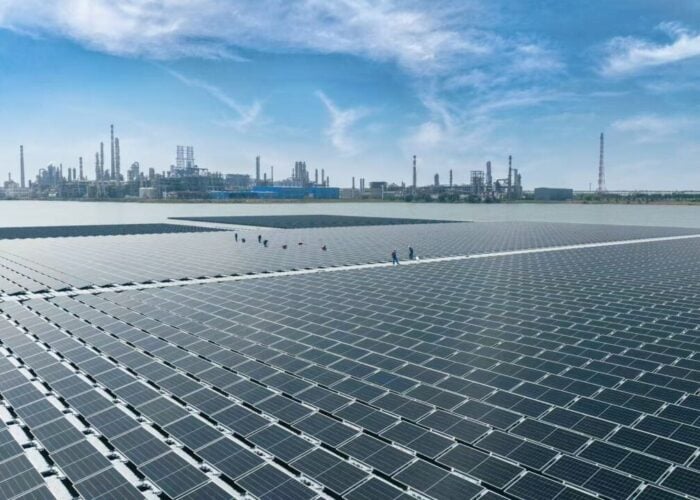
Several factors have overseen an increase in the price of modules. Some of them look sure to ease, while others may be more persistent. Sean Rai-Roche delineates the events behind the rise and speaks to industry experts about what businesses can expect moving forward.
Module prices have risen by up to 25% in the last year as the cost of raw materials and transportation have soared, dampening downstream demand and disrupting the entire solar supply chain. The main driver of this has been an increase in the price of polysilicon, almost tripling in cost since its low in 2020. While analysts believe the cost of polysilicon, and in turn modules, will come down, there is uncertainty as to when, with most predicting higher prices continuing into 2022.
Unlock unlimited access for 12 whole months of distinctive global analysis
Photovoltaics International is now included.
- Regular insight and analysis of the industry’s biggest developments
- In-depth interviews with the industry’s leading figures
- Unlimited digital access to the PV Tech Power journal catalogue
- Unlimited digital access to the Photovoltaics International journal catalogue
- Access to more than 1,000 technical papers
- Discounts on Solar Media’s portfolio of events, in-person and virtual
While polysilicon supply is the most significant factor impacting module costs, shipping chaos borne from COVID-19 has also caused upward pressure on prices. As the true significance of the pandemic dawned in March 2020, both demand and supply of freight collapsed as countries around the world went into lockdown. Since then, demand has recovered but supply, beset by COVID-19 complications, has not increased to meet it, resulting in significantly higher transport costs. While polysilicon prices are expected to fall next year, shipping costs are not, with insiders telling PV Tech Power that the freight industry may never be the same again.
All of this has put substantial pressure on engineering, procurement and construction companies (EPCs) as rising costs have impacted purchasing, project timelines and expected profit margins.
Falling modules prices a case of when, not if
The price of basic monofacial modules at the factory gate in China rose from below US$0.19/w last summer to US$0.24/w as of August, according to Jenny Chase, head of solar analysis at BloombergNEF (BNEF), and prices look set to rise further still in the short term. This was largely due to fierce demand for polysilicon coupled with curtailed availability. As a result, wafer manufacturers sought to lock in supply, signing long term contracts that put further upward pressure on prices. Compounding this was glass shortages and increases in the cost of silver at the end of 2020, although these pressures have abated. Analysts expect last year’s supply shortages to end as some of the largest manufacturers bring significant capacity expansions online.
Polysilicon has gone from a low of around US$6/kg last year to upwards of US$28/kg today, says Chase, which has in turn forced the price of modules up by around 25%. PV InfoLink data supplied to PV Tech Power puts the puts the price at a slightly tighter range, showing polysilicon soaring from a low of US$8.7/kg in 2020 to US$22.2/kg this year. Worldwide demand for polysilicon in 2020 was 140GW, while supply only reached 133GW by the end of the year, according to Corrine Lin, chief analyst at PVInfoLink. Lin argues that planned capacity expansions by polysilicon manufacturers were not brought online soon enough to meet demand.
While Lin puts most of the price pressure down to lagging capacity, Chase says the exact cause of polysilicon supply tightness is uncertain. There was broadly enough supply to meet demand over the year, she says, but bottlenecks occurred. “I think the increasing cost of polysilicon was probably exacerbated in the first half of the year by wafer makers really needing to secure supply, meaning they signed long term contracts for large amounts of inputs at spot price rates,” says Chase, driving up prices even more.
Other material factors include the cost of silver and glass. In November last year, module manufacturers started to lobby the Chinese government to intervene as the price of solar-grade glass went “out of control” after more than doubling in four months. Chase predicts that a recovery of the glass supply, which had brought the cost of modules down US$0.02/w to US$0.18/w earlier this year, will pose no further issues moving forward. Similarly, rising silver prices should not trouble the industry as modules continue to incorporate less of the precious metal and alternatives such as copper-nickel alloys are explored.

But what does the future hold for the price of modules? Will polysilicon supply be enough to meet demand? And when might prices come down again?
Worldwide demand for modules from leading manufacturers is expected to be 160GW this year, with a supply capacity of 180GW by the end of the year, according to PV InfoLink data. The forecast for next year is even more favourable, with total supply hitting 349GW against demand of just 181GW, suggesting prices could drop substantially next year as supply outstrips expected demand.
BNEF expects 183GW of module demand this year, with a higher-end forecast of 204GW. Chase estimates that there is enough polysilicon to meet this demand, with an expected 207GW of supply. Its February 1Q 2021 Global PV Market Outlook Report expected an 18% growth in polysilicon output capacity in 2021 compared with 2020, assuming all factories run as planned. About 60% of this capacity is from existing factories which have experienced bottlenecking, with the remainder coming from new and reopened factories.
Both PV InfoLink and BNEF have pointed to significant expansions to polysilicon production by the largest manufacturers as the reason for expected module price decline. PV InfoLink data shows that Tongwei, Daqo, East Hope, Asia Silicon and TBEA plan to add 245,000 metric tonnes (MT) of polysilicon from Q4 2021 to Q2 2022, equating to around 84GW of added solar module capacity. BNEF expects 265,000MT of added production throughout 2022 – but also includes potential contributions from OCI in Seoul (5,000MT) and Xinte (100,000MT), although the latter isn’t expected until 2023.
Analysts advise that the price of polysilicon, and in turn modules, will come down, either towards the end of the year or in H1 2022. Lin says that PV InfoLink recently revised their polysilicon price forecasts, which initially predicted price rises in Q3 and Q4 due to strong European and US demand. The analyst now expects prices to be flat at around US$26.5/kg moving into the new year. In 2022, it expects the price of polysilicon to drop significantly to US$13.4/kg, down 40%. In turn, modules are expected to plateau at around US$0.246/w in Q4 2021, not coming down to lower levels until at least Q1 or Q2 2022. Nonetheless, both Chase and Lin were certain that prices would come down, it is just a matter of precisely when.
Shipping troubles could be here to stay
While the price of actually producing modules is expected to fall next year, higher shipping costs are here to stay. In March 2020, when the world woke up to the true impact of the pandemic, shipping companies were in disarray. Demand had collapsed, countries were locking down and consumer confidence wasn’t just shaken, it had broken. Since those worrisome days at the start of last year, the shipping industry has enjoyed unprecedented profits. It is currently charging significantly higher prices while delivering a poorer service when compared with that of a year ago, say analysts. As a result, there is no reason why things are likely to change soon, and prices may even go up in the near term.
It currently costs around US$17,000 to move a 40-foot container from Asia to Europe, says George Griffiths, global pricing specialist at S&P Global Platts. A year ago, it cost US$1,650. Asia to the west coast of North America is up from just below US$3,000 a year ago to US$6,500 today, Griffiths notes. This, in turn, puts upwards pressure on module prices as the cost of transportation is now several times what manufacturers are used to.
The rising prices are a direct result of COVID-19. “There have been some periods of large prices rises in the industry, but not on the scale seen in 2020-21,” says Joanna Konings, senior economist of international trade at ING.
At the start of the pandemic, the only things keeping the shipping industry afloat was the movement of personal protective equipment (PPE) and home improvement goods, says Griffith. Meanwhile, containers in Europe and North America were left empty due to cancelled sales, which caused freight rates to increase rapidly, while regular port closures due to COVID-19 outbreaks caused significant backlogs for entire supply chains.
Furthermore, alliances between shipping firms to streamline their operations brokered in 2013/14 meant that fewer ships were being used to transport the same amount of goods, which again had the effect of reducing the supply pool, Griffiths explains. “Container liners seem to have learned to manage capacity better in their alliances,” adds Konings.
Now, demand has rebounded from businesses worldwide as lockdowns have eased, while supply has remained at 2020 levels, causing massive increases in the cost of shipping. “The harpex index, which aggregates world charter rates for containers, is up nearly 450% on a year ago,” says Konings.
Shipping companies are now in the envious position of being in high demand but with substantially less supply, resulting in unprecedented profits. For example, freight rates at Danish shipping giant Maersk increased by 18% in H2 of 2020, compared with 2019, according to the company’s 2020 annual report. And according to consultancy firm Sea Intelligence, the 11 largest shipping companies saw unprecedented operating profits in H2 2020, reaching US$13.3bn.
“The days of three-figure freights from Asia to Europe are long behind us”
George Griffiths, S&P Global Platts
“There’s nothing they can do to create more supply and demand is still outstripping what they have,” says Griffiths, adding that any hopes that the pressure would alleviate in H2 2021 appear to be ungrounded. The most conservative estimates expect prices to start falling in Q1 2022, says Griffiths, although he caveats this by explaining that most industry insiders had expected them to be falling already.
Konings points to new capacity additions that will ease price pressures, but not until 2023. “When the new capacity is ready for use, it will represent a 6% increase after years of low deliveries, which the scrapping of old vessels is not expected to offset,” she says. “So there will be an increase in capacity, which along with global growth will put downward pressure on shipping costs.”
In the meantime, however, “competition for ocean freight capacity is set to remain, while the unbalanced recovery will continue to exacerbate some of the problems for world trade,” says Konings. “It all adds up to more pressure on freight rates in the near term.”
With carriers now able to charge up to US$17,000, why would they ever let them drop again to US$800? asks Griffiths. “The days of three figure freights from Asia to Europe are long behind us,” he says, adding that while crates could come down to under US$10,000 from Asia to Europe, they will never return to the lows of 18 months ago.
The downstream impact on EPCs
EPCs have responded to the rising cost of modules in different ways. Some have delayed projects, while others have taken a hit to their profit margins in order to construct projects on time and keep pipelines manageable.
Nikos Papapetrou, general manager of renewables and storage development at Mytilineos, says the company has responded to the higher prices by pushing back around 10 projects on clients’ behest after close consultation. It has also delayed around five of its own projects.
He says that strong client relationships were crucial in managing expectations and postponing projects. Papapetrou now expects a surge of new installs after Q2 2022, at a greater profit margin, as module prices come down.
Nevertheless, and even with the delayed projects, Mytilineos has installed 50% more capacity this year than it did in the corresponding period last year and around 25% more than in the same period of 2019, says Papapetrou.
BayWa r.e, meanwhile, has seen the cost of modules it purchases increase by around 50% from September 2020, says Tino Weiss, head of global purchasing solar projects. Played out on a larger scale, this increases the cost of a 150MW project by US$15 million, he explains. The company has renegotiated almost all of its contracts with suppliers from November 2020 to April this year as a result of the higher module costs.
Normally under such circumstances, Weiss would recommend postponing projects but with no certainty about when prices might fall it is difficult to advocate. Given this, BayWa r.e did not cancel any projects in its pipeline because of higher module costs. Instead, the German company took a hit on its profit margins. “Investors are willing to reduce their margin expectations or just pay more,” Weiss says.
He cautions, however, that planned polysilicon expansions next year may not translate into lower module costs if myriad companies look to restart their operations in full, causing spikes in demand. BayWa r.e has agreed future contracts with module suppliers based on current polysilicon and sea freight prices but has agreed to reassess the price closer to the project deadline in a risk sharing exercise.
RES has also seen a rise in its module prices, says Tomaso Charlemont, global solar procurement leader at RES. “We estimate most cost impacts will be temporary and that things should revert back to previously anticipated level eventually by 2023.”
Importantly, “module cost per watt increase needs to be put into perspective,” says Charlemont. “Module suppliers are bringing larger wattage modules to the market, meaning you get more watts per container than with smaller modules.” The EPCs agreed that increased module cell sizes have helped to offset some of their costs.
Supply and demand factors have forced up modules price substantially. And, to a lesser extent, so has exploding shipping costs. This has caused EPCs to make tough business decisions, balancing the needs of clients and shareholders with their business goal and pipeline ambitious. While most experts and companies expect the price of modules to fall next year, shipping will not be getting cheaper anytime soon and if it does fall, it won’t be back down to pre-pandemic levels.
Nevertheless, the appetite for solar remains undiminished, especially as governments around the world look to exit COVID-19’s economic slump with energy infrastructure investments. Stakeholders of the industry should be optimistic that short terms pressures will ease, but some caution is perhaps needed about the pace and extent of such easing given the uncertainty that surrounds the many factors at play.






